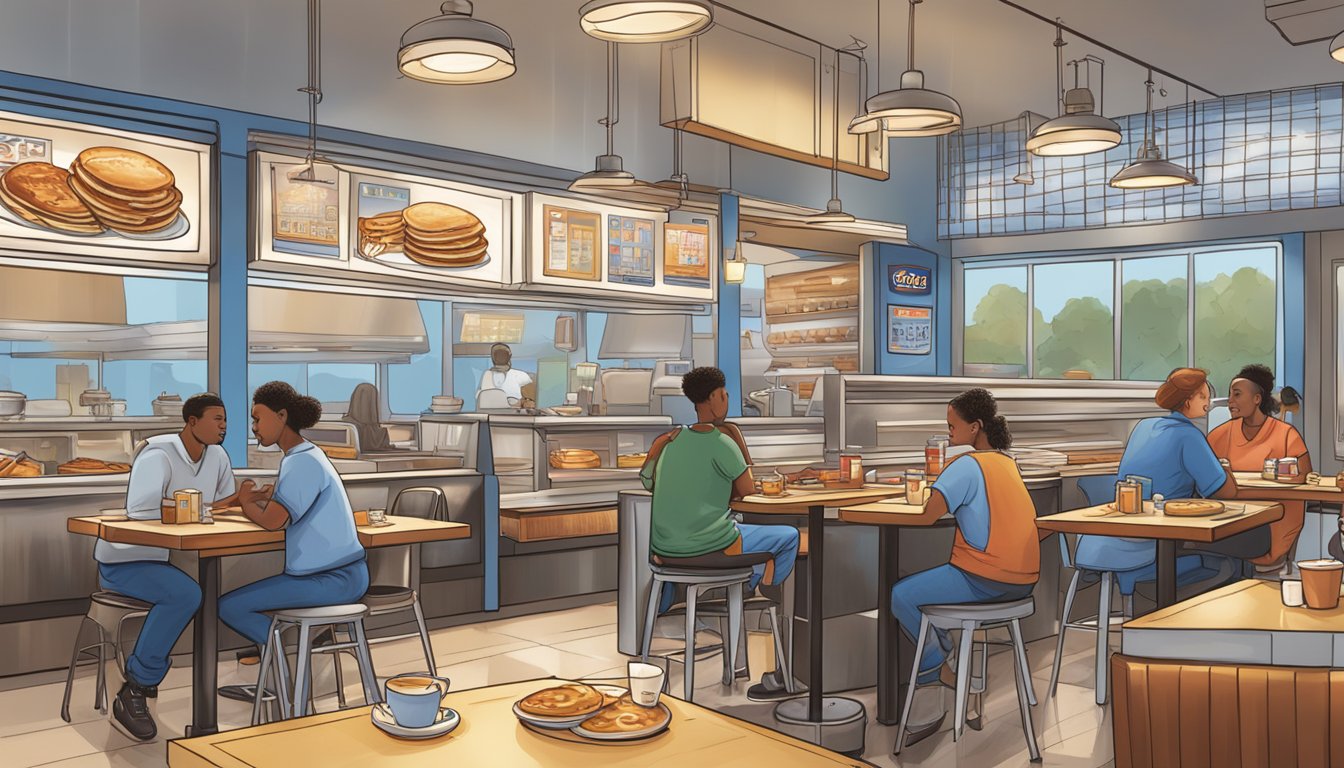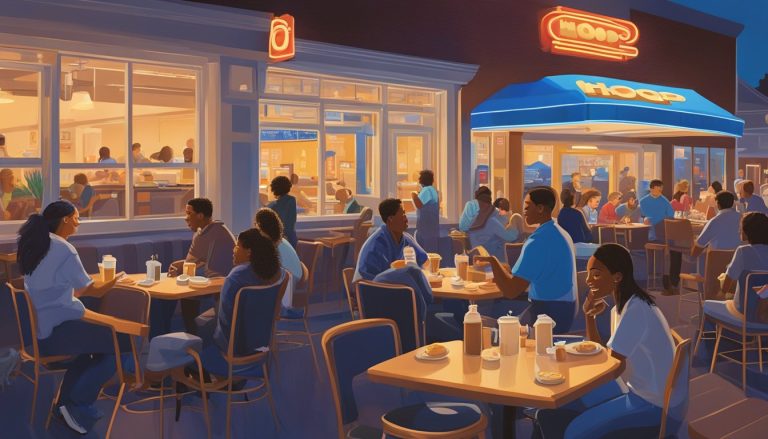IHOP, originally known as the International House of Pancakes, has become an iconic American restaurant chain since its founding in 1958. What began as a modest burger joint in Toluca Lake, California, quickly evolved into a breakfast powerhouse.
The brainchild of Al and Jerry Lapin, IHOP was conceived as a restaurant that could serve delicious pancakes and breakfast foods around the clock. This innovative concept of offering breakfast at any time of day revolutionized the restaurant industry and cemented IHOP’s place in American dining culture.
As IHOP expanded across the United States, it gained popularity for its diverse menu and welcoming atmosphere. The company’s name was officially shortened to IHOP in 1973, making it more memorable and easier to market. This change marked a significant turning point in the brand’s identity and helped propel its growth throughout the following decades.
The Founding of IHOP
IHOP’s origins trace back to 1958 in California, when two entrepreneurial brothers turned their vision for a pancake restaurant into reality. Their concept quickly gained popularity and set the stage for a breakfast empire.
From Dreams to Reality: Al and Jerry Lapin’s Vision
Al and Jerry Lapin, two brothers from New York, saw an opportunity in the growing Southern California restaurant scene. They envisioned a place specializing in pancakes and other breakfast foods, served all day long. The Lapins believed that high-quality ingredients and a diverse menu would set their restaurant apart.
They developed a unique pancake recipe and planned a restaurant concept focused on friendly service and a welcoming atmosphere. The brothers aimed to create a dining experience that would appeal to families and individuals alike.
The Opening of the First Location in Toluca Lake
On July 7, 1958, the first International House of Pancakes opened its doors in Toluca Lake, a suburb of Los Angeles. The restaurant’s location was strategically chosen to attract both locals and Hollywood personalities.
The menu featured a variety of pancake flavors, along with other breakfast items like eggs and bacon. The Lapins’ vision proved successful, as customers flocked to the new eatery. The restaurant’s popularity grew rapidly, leading to plans for expansion.
IHOP’s iconic A-frame building design, which would become a hallmark of the chain, was introduced shortly after the first location opened. This distinctive architecture helped establish IHOP’s brand identity and made the restaurants easily recognizable.
Branding and Identity

IHOP’s iconic branding and visual identity have played a crucial role in its success. The company’s logo and marketing campaigns have evolved over the years while maintaining a sense of nostalgia and familiarity.
Decoding the IHOP Logo
The IHOP logo features a distinctive blue and red color scheme that has become instantly recognizable. The curved “smile” underneath the letters represents warmth and hospitality. This design has remained largely consistent since the 1970s, with only minor updates to keep it fresh and modern.
IHOP’s corporate logo appears on signage, menus, and promotional materials. The blue color evokes trust and reliability, while the red accent adds energy and excitement. This color combination has become synonymous with the IHOP brand.
Nostalgia and Brand Evolution
IHOP has successfully balanced nostalgia with brand evolution in its marketing campaigns. The company often taps into customers’ fond memories of family breakfasts and late-night pancake runs. This approach helps maintain customer loyalty while attracting new generations.
Despite its focus on pancakes, IHOP has occasionally experimented with its branding. In 2018, the company temporarily changed its name to “IHOb” to promote its burger menu. This controversial move generated significant buzz but ultimately reinforced IHOP’s identity as a breakfast icon.
IHOP’s marketing strategies often incorporate elements of Americana and comfort food culture. Seasonal promotions and limited-time menu items keep the brand fresh while staying true to its roots as a family-friendly restaurant.
Menu Expansion

IHOP’s menu evolved from a simple pancake-focused offering to a diverse selection catering to various tastes and meal times. This expansion allowed the chain to attract a wider customer base and solidify its position in the restaurant industry.
The Staple of Pancakes
Pancakes remained at the heart of IHOP’s menu throughout its growth. The chain introduced various flavors and styles to keep customers interested. Classic buttermilk pancakes were joined by innovative options like the Rooty Tooty Fresh ‘N Fruity, introduced in 1985. This popular dish featured pancakes topped with a choice of fruit compote.
IHOP also experimented with unique pancake flavors. The Tahitian Orange Pineapple pancakes became a tropical favorite, combining citrus and island flavors. Seasonal offerings and limited-time specials kept the menu fresh and exciting for regular patrons.
Diversifying for Lunch and Dinner
Recognizing the need to attract customers beyond breakfast hours, IHOP expanded its menu to include lunch and dinner options. This strategic move helped increase foot traffic during traditionally slower periods.
The chain added savory items like burgers, sandwiches, and salads to appeal to the lunch crowd. Dinner offerings included comfort foods such as pot roast, chicken dishes, and steaks. These additions allowed IHOP to compete with other family-style restaurants and casual dining chains.
Despite the menu expansion, IHOP maintained its breakfast-all-day concept. This unique selling point continued to set the chain apart from competitors and satisfied customers’ cravings for breakfast foods at any hour.
Growth and Franchising

IHOP’s expansion from a single restaurant to a nationwide chain was driven by strategic franchising and a focus on breakfast foods. This approach allowed rapid growth while maintaining consistency across locations.
The Rise of a Restaurant Chain
Al and Jerry Lapin opened the first International House of Pancakes in Toluca Lake, California in 1958. The restaurant’s popularity led to quick expansion, with 50 locations by 1960. IHOP’s menu of pancakes, waffles, and other breakfast items resonated with customers.
The company went public in 1961, raising capital for further growth. By 1963, there were over 100 IHOP restaurants across the United States. The chain continued to expand rapidly throughout the 1960s and 1970s.
In 1973, the company officially shortened its name to IHOP for easier marketing. This rebranding coincided with continued expansion and menu diversification.
The Franchise Model and Expansion
IHOP adopted a franchise model early on, allowing for faster growth with reduced corporate risk. Franchisees invested their own capital to open new locations, while IHOP provided the brand, recipes, and operational support.
The franchise system proved successful, enabling IHOP to expand across the country. By 1978, there were over 500 IHOP restaurants. The company continued to refine its franchise model over the years.
In the 1980s and 1990s, IHOP focused on renovating existing locations and diversifying its menu to include lunch and dinner options. This strategy helped attract customers throughout the day.
By 2005, IHOP had implemented a traditional franchise model across its network. The company reached 1,400 locations in 2008 and surpassed 1,500 restaurants in 2010.
Global Footprint

IHOP’s expansion beyond U.S. borders has been strategic and steady. The company has established a presence in multiple countries, adapting its menu and operations to suit local tastes while maintaining its core identity.
Entering the International Market
IHOP’s first international venture was into Canada in 1969. This move set the stage for further expansion. In the 1990s, IHOP entered Puerto Rico and the U.S. Virgin Islands, leveraging their cultural ties to the United States. The company’s approach to international growth has been cautious but deliberate.
IHOP tailors its offerings to local preferences. In Mexico, for example, the menu includes dishes with a Mexican flair alongside traditional IHOP fare. This strategy has helped the brand gain acceptance in new markets.
Specificity in Global Locations
IHOP has made significant inroads in the Middle East. The company opened restaurants in Kuwait, Saudi Arabia, and Bahrain. Dubai has also become a key market for IHOP, with multiple locations serving both locals and tourists.
In Central America, Guatemala has welcomed IHOP restaurants. The brand’s expansion into this region demonstrates its appeal across diverse cultures.
IHOP’s international locations:
- Canada: 30+ restaurants
- Mexico: 40+ restaurants
- Middle East: 50+ restaurants across several countries
- Guatemala: 5 restaurants
The company continues to explore new markets, balancing growth with maintaining quality and brand consistency across its global footprint.
Marketing and Community Engagement
IHOP’s marketing strategies and community initiatives have played a crucial role in solidifying its brand identity and fostering customer loyalty. The company employs creative campaigns and charitable efforts to engage with customers and give back to local communities.
National Pancake Day and Promotions
IHOP launched National Pancake Day in 2006 as an annual celebration. On this day, customers receive a free short stack of pancakes. The event has become a highly anticipated promotion, drawing large crowds to IHOP locations across the country.
In 2018, IHOP executed a bold marketing stunt by temporarily changing its name to IHOb. The “b” stood for burgers, generating significant buzz and media attention. This campaign aimed to promote IHOP’s new line of burgers and showcase its menu diversity beyond breakfast items.
IHOP regularly introduces limited-time offers and seasonal promotions to keep customers engaged. These promotions often feature themed menu items tied to holidays or popular cultural events.
Charitable Contributions
National Pancake Day serves a dual purpose as a charitable initiative. While offering free pancakes, IHOP encourages customers to make voluntary donations to selected charities. This approach has helped raise millions of dollars for various causes since the event’s inception.
IHOP partners with children’s hospitals, leukemia research organizations, and other health-related charities. These partnerships extend beyond National Pancake Day, with ongoing fundraising efforts throughout the year.
The company also supports local communities through sponsorships and volunteer programs. IHOP franchisees often participate in neighborhood events and contribute to local causes, strengthening the brand’s connection to the communities it serves.
Corporate Management and Alliances

IHOP’s corporate structure evolved significantly as the company expanded. Strategic partnerships and acquisitions played a key role in shaping IHOP’s growth trajectory and market position.
DineEquity: Overseeing Growth
In 2007, IHOP Corporation acquired Applebee’s International for $2.1 billion. This move led to the formation of DineEquity, Inc. as the parent company overseeing both restaurant chains. The new structure allowed for streamlined operations and increased buying power.
DineEquity implemented a franchise-focused business model. This approach reduced capital requirements and provided a more stable revenue stream through royalties and franchise fees. The company also invested in technology upgrades across both brands to enhance operational efficiency.
Under DineEquity’s management, IHOP continued to expand its menu offerings and restaurant locations. The company focused on international growth, entering new markets in the Middle East, Asia, and Latin America.
Partnership with Applebee’s
The merger with Applebee’s created synergies between the two restaurant chains. IHOP and Applebee’s shared resources in areas such as supply chain management, marketing, and IT infrastructure. This collaboration resulted in cost savings and improved operational efficiency for both brands.
The partnership allowed for cross-promotion opportunities. IHOP introduced some of its popular breakfast items to Applebee’s menu, while Applebee’s influenced IHOP’s lunch and dinner offerings. This strategy helped both chains expand their customer base and increase sales during different dayparts.
DineEquity implemented a refranchising program for Applebee’s, converting company-owned restaurants to franchise operations. This aligned Applebee’s business model with IHOP’s successful franchise-centric approach.
Adapting to Change

IHOP has navigated significant shifts in the restaurant industry landscape over the years. The company has implemented strategic changes to stay competitive and meet evolving customer preferences.
Family Dining in Modern Times
Family dining establishments face new challenges in today’s fast-paced world. IHOP has responded by expanding its menu beyond breakfast fare. The chain now offers a diverse selection of lunch and dinner options, including burgers and steaks.
IHOP’s temporary name change to IHOb in 2018 highlighted this menu expansion. The move sparked widespread discussion and drew attention to their new Ultimate Steakburgers line.
To appeal to health-conscious diners, IHOP has introduced lighter options and accommodated various dietary preferences. This strategy aims to attract a broader customer base while retaining loyal pancake enthusiasts.
Restructuring for the Future
IHOP has implemented structural changes to adapt to market pressures. The company has focused on enhancing its digital presence and improving its takeout and delivery services.
In response to declining foot traffic, IHOP has invested in restaurant renovations. These updates create a more modern dining atmosphere while maintaining the brand’s familiar comfort.
IHOP has also explored new restaurant formats, including smaller locations and non-traditional spaces. This flexibility allows the chain to enter markets that may not support a full-size restaurant.
The company continues to balance its iconic pancake offerings with menu innovations. This approach helps IHOP maintain its identity while adapting to changing consumer tastes and dining habits.
Looking to the Future

IHOP continues to innovate and adapt to changing consumer preferences while maintaining its core identity as a beloved pancake destination. The company focuses on expanding its menu options and enhancing the dining experience for customers.
Innovation in Full-Service Dining
IHOP is exploring new technologies to streamline operations and improve customer service. The chain is testing tableside ordering tablets and mobile app ordering to reduce wait times and enhance convenience.
IHOP is also expanding its menu to cater to diverse dietary needs. New offerings include plant-based options, gluten-free items, and healthier alternatives to traditional favorites.
The company is experimenting with smaller-format restaurants in urban areas to reach more customers. These locations feature streamlined menus and faster service to accommodate busy city dwellers.
Keeping the Legacy Alive
IHOP remains committed to its roots as a pancake destination. The chain regularly introduces limited-time pancake flavors to keep the menu fresh and exciting for customers.
The company continues to focus on creating a welcoming family atmosphere in its restaurants. IHOP is updating its interior design to blend modern elements with nostalgic touches that evoke its 1950s origins.
IHOP is investing in staff training programs to ensure consistent quality and service across all locations. The company recognizes that its employees play a crucial role in maintaining customer loyalty and upholding its reputation.




